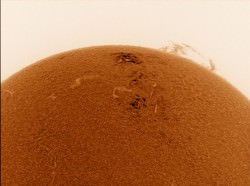Ask anyone, “what color is the Sun”? and they’ll tell you the obvious answer: it’s yellow.
But is it really?
Please don’t go check, it’s not safe to look directly at the Sun with your unprotected eyes.
From our perspective it does look a little yellow, especially after sunrise or shortly before sunset,
But don’t be fooled.
If you could travel into space and look at the Sun without going blind, you’d find that it’s actually white, and not yellow.
Using a prism, you can see how sunlight can be broken up into the spectrum of its colors: red, orange, yellow, green, blue, indigo and violet. When you mix all those colors together, you get white.
Here’s the strange part.
If look at all the photons coming in, our star is actually sending the most photons in the green portion of the spectrum,
Our Sun appears yellow to us because of the atmosphere.
Photons in the higher end of the spectrum – blue, indigo and violet – are more likely to be scattered away, while the lower end of the spectrum – red, orange and yellow – are less easily scattered.

When there’s smoke and pollution in the air, it enhances the effect and it will look even redder.
If the Sun is high in the sky, where it has the least amount of atmospheric interference, it will appear more blue.

But really, the Sun looks like a pure white ball – especially when you’re out in space.
Interestingly, the color of the Sun is very important to astronomers. They use a technique called spectroscopy to stretch out the spectrum of light coming from a star. Dark lines in this spectrum tell you exactly what it’s made of.
You can see which stars have high amounts of metals, or which are mostly hydrogen and helium, leftover from the Big Bang.
This color also tells you the temperature of the star. Cooler stars are actually redder. Betelgeuse is only 3500 Kelvin. Hotter stars, like Rigel, can get above 10000 Kelvin, and they look blue.
Our own Sun has a temperature of almost 5800 Kelvin, and when viewed outside of our atmosphere, appears white. in colour.


i dont think thats true because when a star is white (believe it or not) it is the hottest temperature a star could be. the color of the sun is truly yellow. trust me, we are studying this in class(and i’m in college)!!! : )
Pay closer attention in class or go to a better school. Check NASA.gov or any other credible reference… the Sun is white.
wow i always thought the sun was yellow
“In popular culture, the Sun is yellow. But did you know that the color of the Sun is actually white?”
It actually is all colours, minus the dark lines seen across its visible spectrum. The intensity of the colours is what varies, where a peak at λ max @ 480nm., according to its photosphere mean temperature (as calculated by Wien’s law.)